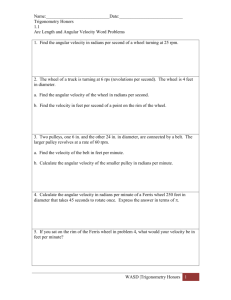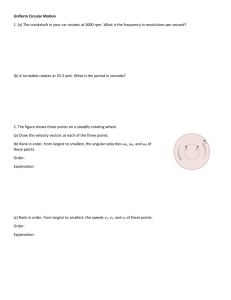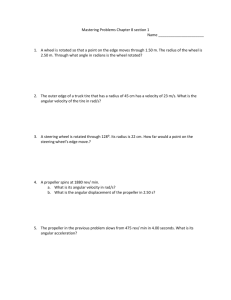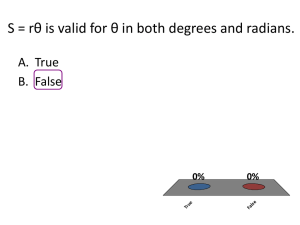Jill's Angular Velocity Notes
advertisement
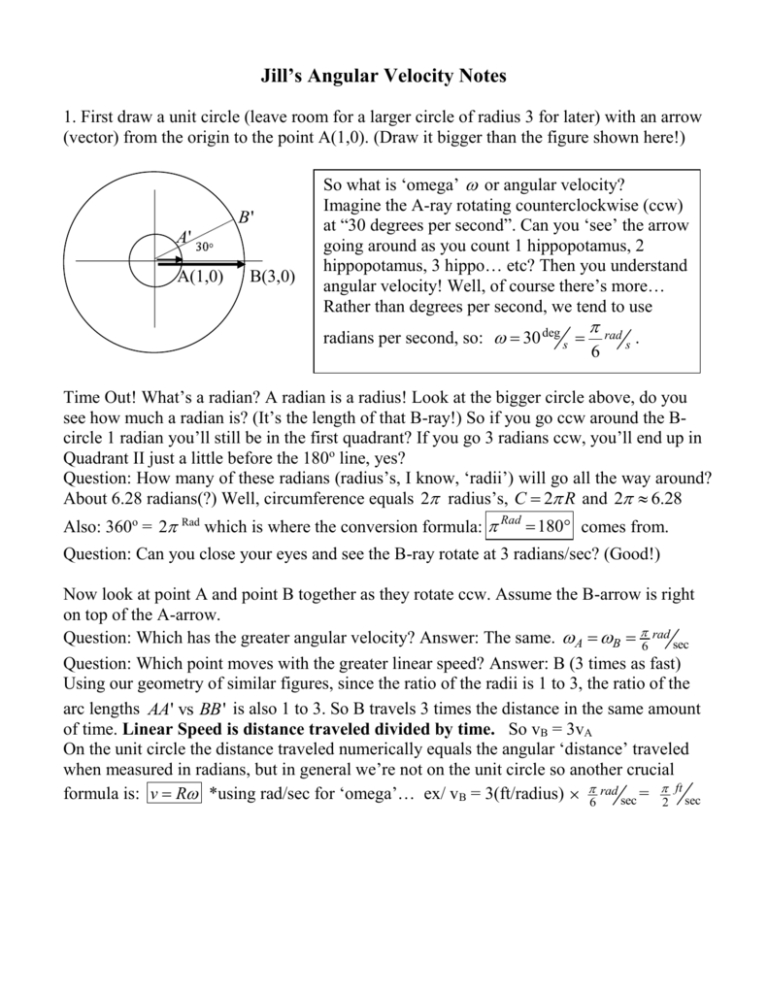
Jill’s Angular Velocity Notes 1. First draw a unit circle (leave room for a larger circle of radius 3 for later) with an arrow (vector) from the origin to the point A(1,0). (Draw it bigger than the figure shown here!) B' A' A(1,0) B(3,0) So what is ‘omega’ or angular velocity? Imagine the A-ray rotating counterclockwise (ccw) at “30 degrees per second”. Can you ‘see’ the arrow going around as you count 1 hippopotamus, 2 hippopotamus, 3 hippo… etc? Then you understand angular velocity! Well, of course there’s more… Rather than degrees per second, we tend to use radians per second, so: 30 deg s 6 rad s . Time Out! What’s a radian? A radian is a radius! Look at the bigger circle above, do you see how much a radian is? (It’s the length of that B-ray!) So if you go ccw around the Bcircle 1 radian you’ll still be in the first quadrant? If you go 3 radians ccw, you’ll end up in Quadrant II just a little before the 180o line, yes? Question: How many of these radians (radius’s, I know, ‘radii’) will go all the way around? About 6.28 radians(?) Well, circumference equals 2 radius’s, C 2 R and 2 6.28 Also: 360o = 2 Rad which is where the conversion formula: Rad 180 comes from. Question: Can you close your eyes and see the B-ray rotate at 3 radians/sec? (Good!) Now look at point A and point B together as they rotate ccw. Assume the B-arrow is right on top of the A-arrow. Question: Which has the greater angular velocity? Answer: The same. A B 6 rad sec Question: Which point moves with the greater linear speed? Answer: B (3 times as fast) Using our geometry of similar figures, since the ratio of the radii is 1 to 3, the ratio of the arc lengths AA ' vs BB ' is also 1 to 3. So B travels 3 times the distance in the same amount of time. Linear Speed is distance traveled divided by time. So vB = 3vA On the unit circle the distance traveled numerically equals the angular ‘distance’ traveled when measured in radians, but in general we’re not on the unit circle so another crucial formula is: v R *using rad/sec for ‘omega’… ex/ vB = 3(ft/radius) 6 rad sec = 2 ft sec Angular Velocity Notes 2. Period vs Frequency T p.2 1 f Question: If omega equals… 6 rad sec 30 /sec , how long does it take to cover 360o? Answer: 360/30 = 12 sec. This is the period (fundamental period). We write T = 12 sec/revolution or just T = 12 sec. (The capital ‘T’ tells us it’s special! ) Question: If it takes 12 seconds per revolution, then how many revolutions are turned in 1 second? 12sec 1rev 1 Answer: f rev sec Notice the units of T and f are reciprocals. 1rev 12sec 12 Period is the reciprocal of frequency. Most math books leave out the concept of frequency. (You’ll see angular frequency.) In physics, you’ll learn that the SI units of frequency used to be cps (cycles per second). Now, the units are call hertz. So when the frequency of the voltage is 60Hz that means the voltage oscillates at 60 cycles per second. RPM (revolutions per minute) is a very common frequency unit. 360 2 Question: If T = 12 sec, what is omega, ? Answer: or rad sec 12sec 12 6 2 A big, big (really big!) formula to memorize is: 2 f *using radians T Ex/ What is the angular velocity of a pulley that turns 20 revolutions every 60 seconds? 1 Looking at the units (rev/sec), we see that we’re give frequency: f = rev/sec. 3 2 rad So using our formula (that we just memorized!)… 2 13 s 3 Angular Velocity Notes p. 3 3. Jill’s Problems The tractor, pulley, or gear-ratio problem. In these problems (unlike pts A & B), the omega’s (angular velocities) are not equal but the linear speeds are equal. Also in gear-ratio problems, linear speed is equal, vC vD and since v R Rcc RDD C RD . The Gear-Ratio Theorem D RC In words, if the ratio of 2 gears is 3 to 1, then their angular velocities and frequencies (since 2 f ) are in a ratio of 1 to 3 (a reciprocal relationship). The rear wheel of the tractor has a 2ft radius, RD = 2 ft and RC = 0.9 ft. The rear wheel rotates at 20 rev/min. (a) What is the linear speed of wheel D? (on it’s edge) (b) What is the linear speed of wheel C? (on it’s edge) (c) What is the angular frequency of wheel C? Solution: First of all, note we’re give fD = 20 rpm = Secondly, since 2 f , 2 20rev 1 rev = 60sec 3 sec 13 23 rad s 4 ft 3 s (b) vC = vD since the belt rides on both wheels (like a pulley problem). f 2 f R 20 rev fc = (c) fc = ? From our gear-ratio theorem: C c D so… 1c 0.9 D f D RC 27 s 3 (a) v R vD = 2( 23 ) = Oh yeah, ‘they’ wanted the answer in rev/min!!! fc 2 400 fC = rpm 20 0.9 9 I’m betting the book’s answers for parts (a) and (b) were in ft/min??? We coulda/shoulda left fC in rev/min, so fC = 20 rev/min & The teeter-totter problem! 37 degree angular displacement in 0.7 sec. Stan is 8 ft from the fulcrum. Ben is 5 ft from the fulcrum. Find the angular velocity for each. 37 deg S B 0.7 sec rad 37 180 .7 sec (1 degree with… using Rad 180 ) = .923 rad/sec Angular Velocity Notes p. 4 3. Jill’s Problems (continued) The train wheel with the extra 1 inch flange problem! The wheel that rides on the rail has a radius of 15 inches. It’s linear speed (with respect to its center) matches the linear speed of the train (and the center of the wheel) as it moves down the railroad track. The flange is sort of a second wheel which extends 1 inch further to keep the 15 inch wheel on the rails. Let RA = 15 inches and RB = 16 inches. If vTrain = 60 mph = 88.2 ft/s, What is the speed on the outer edge of the flange, vB = ? Solution: In this problem, A B and vA = vTrain = 88.2 ft/s First find omega first using v R . Watch out, we’ll need RA = 15in = 1.25 ft ft (changing inches to feet) so 88.2 ft/s = 1.25 rad A A 70.6 rad s . in Now use v R again but with vB = 16 rad = 1130 in/s = 94.1 ft/s > 88.2 ft/s. 70.6 rad s 4. Concept Questions/Problems What is the angular velocity of a person on earth with respect to the earth’s axis. 2 Using have the student spend time trying to figure out what the time period, T, T is here. 2 rad Answer: T = 1 day or 24 hours or … hence, 2 rad = 15 deg/hr. day 24 12 hr What is the angular velocity of the earth about the sun? (Assume a circular orbit.) 2 Using have the student spend time trying to figure out what the time period, T T, is here. 2 rad Answer: T = 1 year or 365 days or … hence, 2 rad < 1 deg/day. yr 365.25 day What is the speed of a person standing on the equator with respect to the earth’s axis? Answer: Use v R and an earth radius of 6.38 x 106 m (meters) v = 1.67 x 106 m/hr or 1.67 x 103 km/hr or 1040 mph What is the speed of the earth moving around the sun? (Assume the sun is sitting still.) Answer: Use v R and an earth-sun mean radius of 1.50 x 1011 m (meters) 2 rad 1day m 24 hr 1.08 108 m hr 1.08 105 km hr 67,000 mph v = 1.5 1011 rad 365 day


